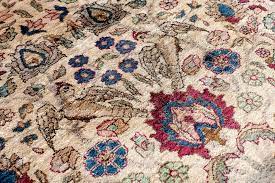What Makes Silk Rugs Exceptional?
Silk rugs, considered the epitome of luxury, have a fascinating history. Silk textile production originated in China, but it was during the Sassanid Empire (3rd – 7th centuries) in Persia that silk fabric manufacturing flourished. It’s unclear whether China or Persia initiated silk rug production.
The oldest handmade silk rugs are Persian, from the Safavid Period. Over time, regions producing oriental rugs – Persia, Turkey, Turkestan, Tibet, and China – began crafting rugs entirely or partially from silk. The finest silk rugs have both their pile and base (the weft and warp fringes) made of silk. Silk’s delicate texture, reflective and luminous properties, and the richness and intensity it lends to dyes surpass the finest wool.


Silk, a thin yet strong fiber, transforms a rug’s appearance, even when the artist used partially to highlight a particular design. Its prismatic structure reflects light, enhancing the colors’ brightness.
Silk’s flexibility and durability, coupled with its intrinsic value and beauty, outshine all other natural and synthetic fibers. As a commodity, it was transported through the most famous trade route in the world and created immortal legends.
Today, silk remains a luxury. Silk rugs, with their unmistakable luminescence, shine, and soft, sumptuous texture, mesmerize. Thinner than human hair, silk fibers refract ambient light, producing a bright, elegant appearance. Despite the tedious process of unwinding thousands of meters of silk from a cocoon, the resulting handmade silk rugs are exceptionally desirable for their incomparable beauty and luxurious appearance.

Figalli Oriental Rugs
We do not sell rugs. We bring rare works of art to your home in the form of rugs.
Our services
You are Protected
Copyright © 2023 Figalli Oriental Rugs, All rights reserved. Desenvolvido por Agência DLB – Agência de Marketing Digital em Porto Alegre
